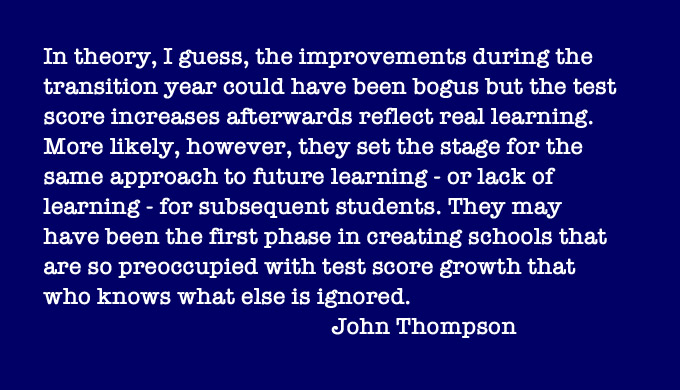Do NOLA Test Score Increases Demonstrate Real Learning Gains?

By John Thompson.
Author’s Note: This post was drafted before the election, but held until after the anticipated defeats of Donald Trump and Massachusetts’s State Question 2. The assumption was that the timing would be right for a balanced discussion of the actual record of choice-driven reforms. Now, both Trump and true believers in scaling up charters plan to ramp up their reality-free agendas. Regardless, even in the age of Trumpism, educators need evidence—based analyses of the actual outcomes of market-driven reforms.
If test-driven, competition-driven school reform has taught us anything, it is this: When schools post gains in state test scores, those numbers may mean something or they may mean nothing. Some of those bubble-in increases might be evidence of meaningful learning – just as they might mean that teach-to-the test has taught students destructive habits that will undermine their futures in college and post-school life.
By now, scholars should forsake the use of the terms “student achievement” and “student performance” when talking about test score “outputs.” Especially in schools and systems that focus on bubble-in accountability, the jury is in and sharp increases on graphs displaying test score boosts do not show that students are getting better educations. Researchers should accept the burden of proving that test score growth is evidence of increased learning or school improvement before saying that they are evidence of policies that are beneficial to students.
The latest report by the Education Research Association on New Orleans school reform, “Extreme Measures: When & How School Closures & Charter Takeovers Benefit Students,“ is consistent with the solid research that informs its previous scholarship. And it includes the important qualifying statement that, “prior evidence suggests that schools that are effective in generating high test scores are not consistently more effective with other student outcomes.” When the ERA released its landmark “What Effect Did the Post-Katrina Reforms Have on Student Outcomes?,“ however, a diverse variety of scholars participated in the discussion of its findings. Fewer dissenting opinions were expressed when the new paper was released.
As with the case with the ERA’s “What Effect Did the Post-Katrina Reforms Have on Student Outcomes?”, by Doug Harris and Matthew Larsen, a graph that illustrates the NOLA trend line in test score growth presents the central argument. Harris and Larsen showed that New Orleans test score growth was increasing Do NOLA Test Score Increases Demonstrate Real Learning Gains? - Living in Dialogue:
